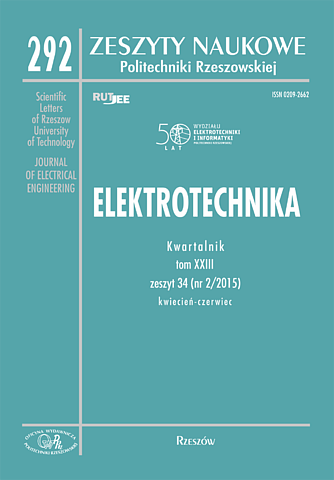Abstract
The main goal of our paper is to present some results of E-field recordings obtained from a new measuring site in Rzeszow in the summer of 2014 during lightning and thunderstorm activity the in the south-east of Poland. To record the lightning signatures in the E-field we have used a field mill with a rotating dipole - an E-field sensor to measure the electrostatic component of the field intensity variations in the frequency range from 0 to 10 Hz, and, in addition we used an electric flat plate antenna (E-field change meter) operated with the charge amplifier unit in the frequency range from 0.5 to 3 MHz. We have undertaken the post-processing analysis of the gathered E-field lightning data to distinguish different components of the lightning cloud-to-ground (CG) or intracloud strokes (IC) both in the time and time-frequency domain. For this purpose we have used the standard Matlab procedures and algorithms to evaluate the Short-Time Fourier Transform (STFT) and calculate the power spectrum density (PSD) for each of our lightning flash-related E-field record. In this way we can recognize different stages of a single or multiple CG flash evolution, such as the preliminary breakdown (PB), the return stroke (RS) or continuing current (CC) events. Some valuable results of our PSD analysis related to adequate and reliable discrimination of RS stages in multiple CG flashes are shown. We postulate that such PSD analysis could be implemented in discrimination algorithms used in the regional or global lightning detection and location systems, and enhancing their efficiency in the RS or CC stroke change determination. Another important part of the measuring equipment of lightning registration system in Rzeszow, including a fast digital video camera and additional digital photo camera working with own independent acoustic and optical lightning trigger, and a GPS unit, are also described. These devices can be used together with simultaneous E-field recordings for better determination and understanding of different stages of complex lightning discharge phenomena.
References
[2] Karunarathne S., T.C. Marshall, M. Stolzenburg, N. Karunarathna, L. E. Vickers, T. A. Warner, and R. E. Orville (2013), Locating initial breakdown pulses using electric field change network, J. Geophys. Res. Atmos., 118, 7129–7141, doi:10.1002/jgrd.50441.
[3] Rakov V.A., Electromagnetic methods of lightning detection, Surv. Geophys., 34:731-753, 2013, doi 10.1007/s10712-013-9251-1.
[4] Gamracki M., Modelowanie matematyczne propagacji piorunowego zaburzenia elektromagnetycznego nad stratną ziemią, Przegląd Elektrotechniczny, ISSN 0033- 2097, NR 7/2014.
[5] Marshall, T., W. Schulz, N. Karunarathna, S. Karunarathne, M. Stolzenburg, C. Vergeiner, and T. Warner (2014), On the percentage of lightning flashes that begin with initial breakdown pulses, J. Geophys. Res. Atmos., 119, 445–460, doi:10.1002/2013JD020854.
[6] Oppenheim, Alan V., Ronald W. Schafer, and John R. Buck. Discrete-Time Signal Processing. 2nd Ed. Upper Saddle River, NJ: Prentice Hall, 1999.
[7] Rabiner, Lawrence R., and Ronald W. Schafer. Digital Processing of Speech Signals. Englewood Cliffs, NJ: Prentice-Hall, 1978.
[8] Rakov V.A., Uman M.A., Lightning: Physics and Effects, Cambridge Univ. Press, 2003, New York.
[9] Barański P., Michnowski S., Masłowski G., Gajda W.: Signatures of electric field changes associated with the continuing current stage of cloud-to-ground flashes, Proceedings of the 13-th International Conference on Atmospheric Electricity, ICAE 2007, Beijing, China, vol. I, 489–492.
[10] Baharudin Z.A., Ahmad N.A., Fernando M., Cooray V., and Mäkelä J.S., Comparative study on preliminary breakdown pulse trains observed in Johor, Malaysia and Florida, USA, Atmospheric Research, No.117 p.111-121, 2012.
[11] Masłowski G., P. Barański, Karnas G.: Electric field frequency spectra of multiple cloud-to-ground lightning flashes recorder in the Warsaw region by Local Lightning Detection Network, Proceedings of the 14-th International Conference on Atmospheric Electricity, ICAE 2011, Rio de Janeiro, Brazil (wersja elektroniczna).
[12] Masłowski G., Barański P., Karnas G.: Spectral characteristics of the electric field related to the preliminary breakdown stage of cloud-to-ground lightning flashes, Proceedings of the 15-th International Conference on Atmospheric Electricity, ICAE 2014, Norman, Oklahoma, USA (wersja elektroniczna).
[13] Karnas G., Masłowski G., Barański P., Berliński J., Pankanin G., Instrumentation and data analysis process at the new lightning observatory in Poland, Przegląd Elektrotechniczny (Electrical Review) R. 89 NR 6/2013.
[14] Masłowski G., Barański P., Natural Lightning Channel Evolution Obtained from High-Speed Digital Video Camera Recordings, Publs. Inst. Geophys. Pol. Acad. Sc., D-73(412), 2009.
[15] Stolzenburg M., Marshall T.C., Karunarathne S., Karunarathna N., Orville R.E., Branched dart leaders preceding lightning return strokes, Journal of Geophysical Research: Atmospheres, 2014, USA., doi:10.1002/2013JD021254.
[16] Sobolewski K., Karnas G., Barański P., Masłowski G., Analiza sygnatur pola elektrycznego wyładowań atmosferycznych w rejonie Bieszczad na podstawie kompleksowych pomiarów impulsów fali EM w paśmie częstotliwości od 0 do 3 MHz wykonanych w AOS PRz i PW w Bezmiechowej w maju 2014 r., Zeszyty Naukowe Wydziału Elektrotechniki i Automatyki Politechniki Gdańskiej, ISSN 2353- 1290, Nr39, Gdańsk, 2014.
[17] Łoboda M., Betz H.D., Barański P., Wiszniowski J., Dziewit Z., New Lightning Detection Networks in Poland – LINET and LLDN, The Open Atmospheric Science Journal 01/2009; 3:29-38. doi:10.2174/1874282300903010029.





